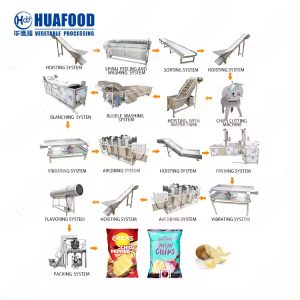
In the world of snack foods, potato chips remain an enduring favorite, loved for their crispy texture and delicious flavor. Behind every bag of these beloved snacks lies a sophisticated process involving various stages, from raw potato to crispy delight. A modern potato chip-making line encompasses a series of essential components, each playing a crucial role in ensuring the quality, efficiency, and safety of the production process.
Potato chip production line – production process
1. Pre-Cleaning Stage:
Before the potatoes are processed, they undergo a pre-cleaning stage to remove any visible dirt or debris. This initial step is essential for maintaining hygiene standards and ensuring that only high-quality potatoes enter the production line.
2. Peeling and Slicing:
Once the potatoes are pre-cleaned, they move on to the peeling and slicing stage. Here, advanced machinery efficiently peels the potatoes and slices them into thin, uniform slices. Consistency in slice thickness is crucial for achieving uniform frying and ensuring consistent quality across batches.
3. Rinsing and Blanching:
After slicing, the potato slices undergo rinsing to remove excess starch. Subsequently, they are blanched briefly in hot water or steam. Blanching serves multiple purposes, including inhibiting enzymatic activity, preserving color, and reducing microbial load.
4. Vibration Draining and Drying:
Following blanching, the potato slices undergo a vibration-draining process to remove excess water. This step is crucial to prevent oil splattering during frying and to ensure the desired crispiness of the final product. Subsequently, the slices are dried using airflow to achieve the optimal moisture content for frying.
5. Frying:
The dried potato slices are then subjected to frying in hot oil. This stage is perhaps the most critical in the potato chip-making process, as it determines the texture, flavor, and overall quality of the final product. Advanced frying systems ensure precise control over temperature and cooking time, resulting in consistently crispy and flavorful chips.
6. Oil Draining and Cooling:
Once fried to perfection, the potato chips undergo another round of vibration draining to remove excess oil. They are then cooled using airflow to bring down their temperature and ensure safe handling during subsequent processing stages.
7. Seasoning and Flavoring:
After cooling, the potato chips move on to the seasoning and flavoring stage. Here, they are coated with a carefully formulated blend of seasonings to impart the desired taste profile. Advanced seasoning systems ensure uniform distribution of flavorings, enhancing the overall eating experience.
8. Packaging:
The final step in the potato chip-making line is the packaging. Advanced packaging machinery fills bags with freshly made potato chips, seals them to maintain freshness, and labels them with product information. Packaging plays a crucial role in preserving the quality and shelf life of the chips, ensuring that consumers enjoy them at their best.
Potato chip production line:Not just potato chips
The Potato Chips Making Line isn’t just for potato chips. It is versatile and can be used for frying different types of vegetable and fruit snacks such as frozen french fries, sweet potato chips, and banana chips, among others.
The potato chip-making line works together seamlessly to transform raw potatoes into the crispy, flavorful snacks loved by millions worldwide. From pre-cleaning to packaging, each stage is meticulously designed to ensure efficiency, consistency, and quality, meeting the demands of both producers and consumers alike.
 Henan huafood
Henan huafood
